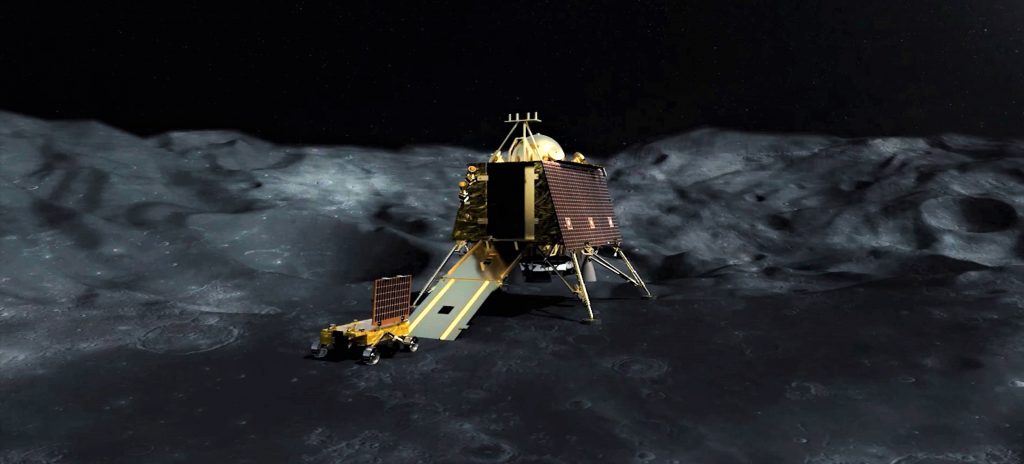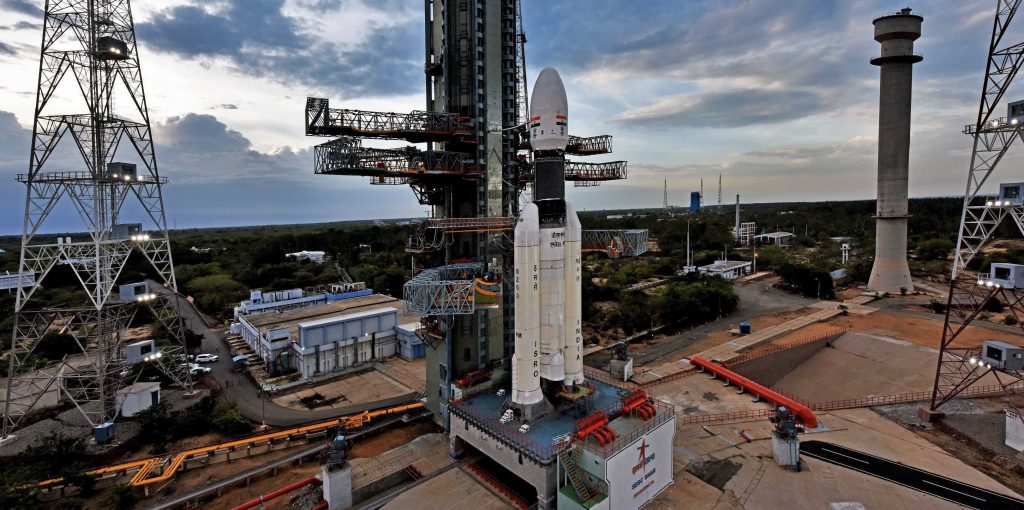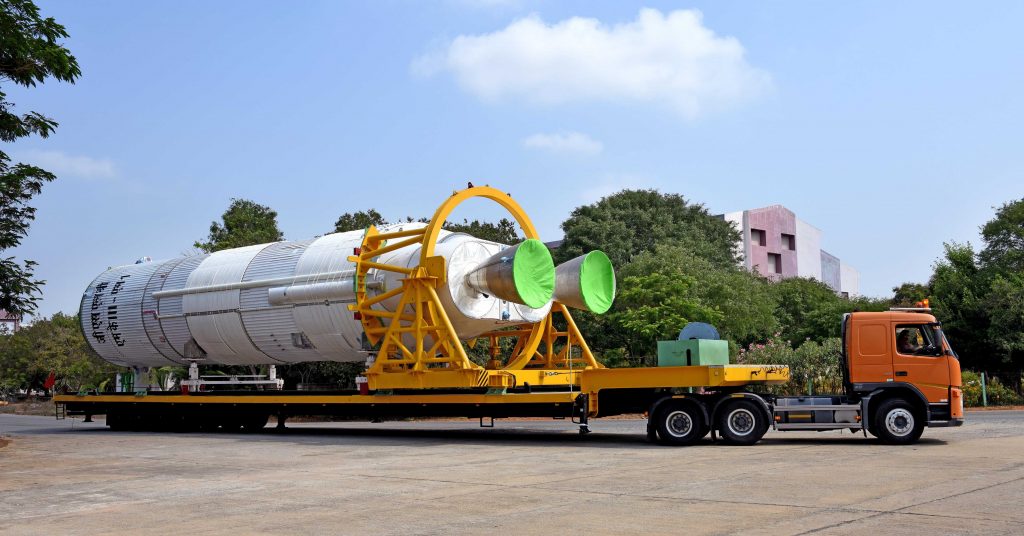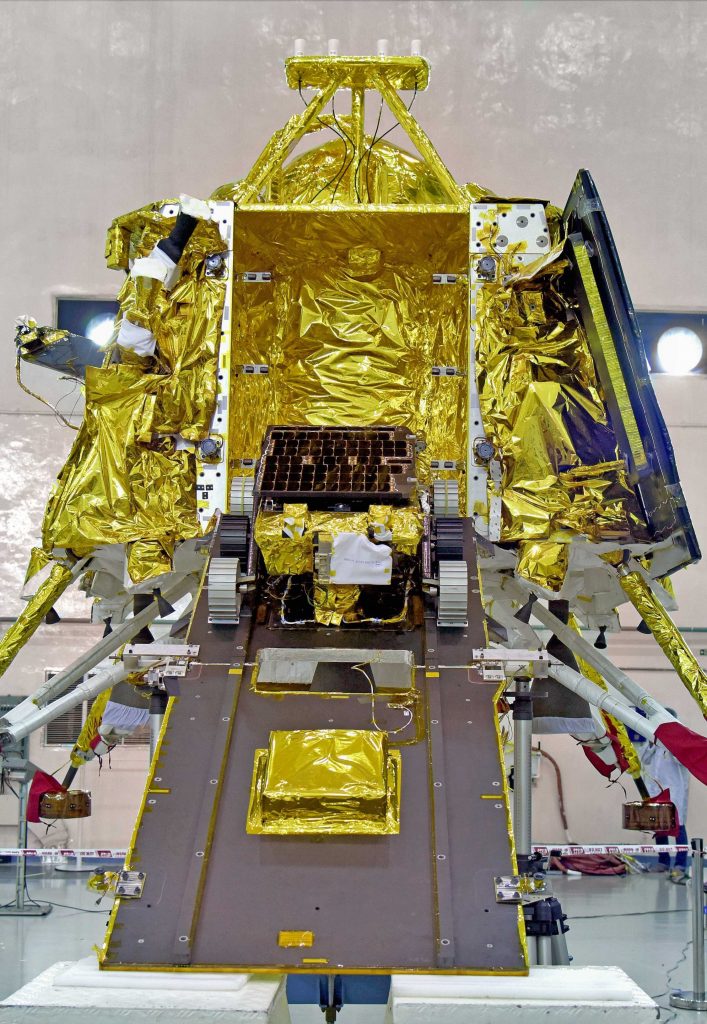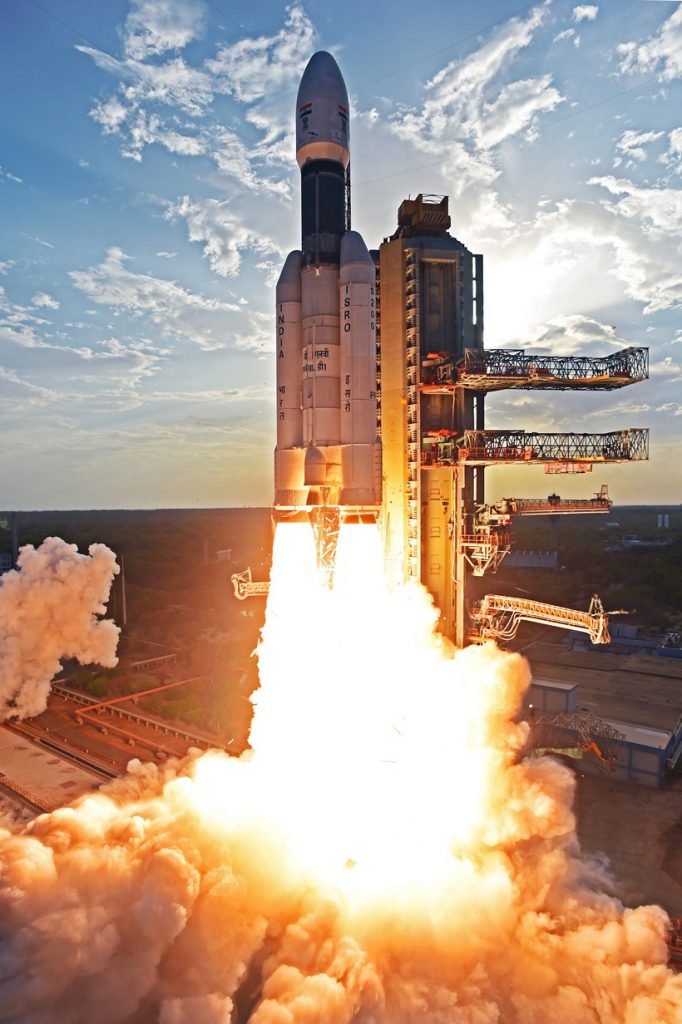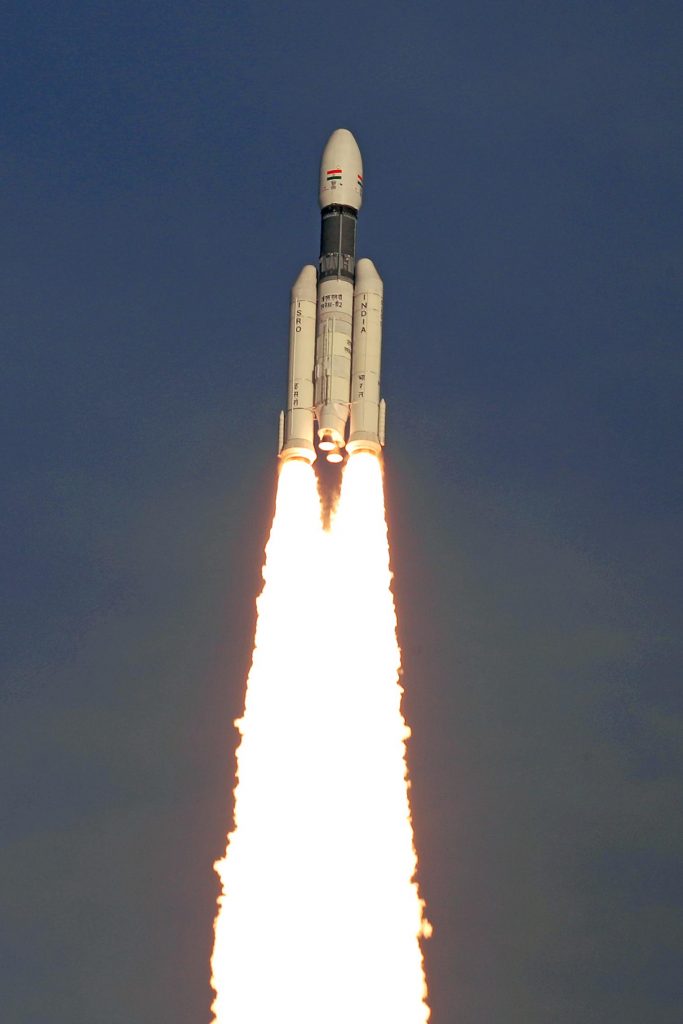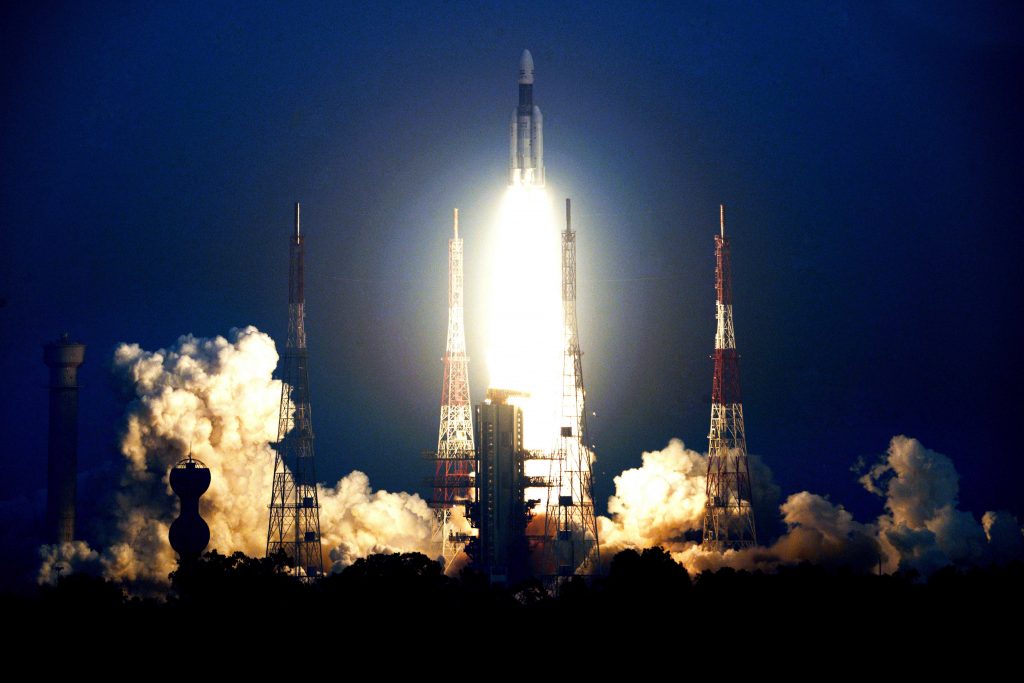

News
India could become the fourth country ever to soft-land a spacecraft on the Moon next week
The Indian Space Research Organization (ISRO) is perhaps just a few weeks (maybe days) away from attempting to place the country in the history books, hopefully setting India up to become the fourth nation on Earth – after the Soviet Union, United States, and China – to successfully soft-land on the Moon.
Known as Chandrayaan-2, the mission seeks to simultaneously launch a lunar orbiter, lander, and rover, altogether weighing nearly 3900 kg (8600 lb) at liftoff. If successful, the trio of spacecraft will remain integrated for about two months as the orbiter slowly raises its Earth orbit to eventually intercept and begin orbiting the Moon. Although originally expected to launch on Sunday, July 14th (July 15th local time), a bug with the Indian-built launch vehicle’s upper stage has pushed Chandrayaan-2 outside its original launch window, which ended today (July 16th). Depending on the complexity of the mission profile ISRO is using, the delay should be no more than a few days to a few weeks before the next launch window opens.
Editor’s note: Following ISRO’s July 15th scrub, the Chandrayaan-2 Moon lander mission has been rescheduled for launch no earlier than (NET) 2:43 pm local time, July 22nd (2:13 am PDT/9:13 UTC, July 23rd).
Fourth to the Moon (in one piece)
- All the way back in 1966, the Soviet Union (USSR) became the first to successfully soft-land an uncrewed spacecraft on the Moon with a mission known as Luna-9. Some four months after the momentous achievement, the United States became the second, safely landing Surveyor-1 on the Moon in June 1966.
- At the height of the space race, huge amounts of money was being funneled into these milestones, permitting the companies, institutions, and space agencies building, launching, and operating the individual missions to almost throw hardware at the metaphorical wall until something stuck. With the Soviet space program, this involved 17 failures, two successes, and one partial success in the first 7 years of the Luna initiative, culminating in Luna 9’s successful landing in February 1966.
- The US had three major separate programs known as Ranger, Lunar Orbiter, and Surveyor, the former of which was meant to simply fly past or impact the Moon to acquire detailed photos of its surface. Ranger suffered five consecutive failures and one partial failure before three full successes, while Orbiter was a complete success (5/5) and Surveyor failed only 2 of 7 attempts.
- Ultimately, this little snippet of history is simply meant to emphasize the utterly different approaches of those pathfinder programs relative to modern exploration efforts. In the case of ISRO’s Chandrayaan-2, failure would likely mean several years of delays before the next possible attempt – there is no concurrent (verging on mass-) production of multiple spacecraft like there was with Surveyor and Luna.
- Just shy of 50 years after the back-to-back first and second soft landings of Luna-9 and Surveyor-1, China became the third nation on Earth to successfully soft-land on the Moon with its 2013 Chang’e-3 mission, featuring a lander and rover. This was followed by Chang’e-4 in 2018, which continues to successfully operate 8 months after achieving the first successful soft-landing on the far side of the Moon.
- Finally, just several months ago, private company SpaceIL – supported by Israeli aerospace company IAI – attempted (albeit unsuccessfully) to make Israel the fourth country to land on the Moon.
Indian spacecraft, Indian rocket
- This finally brings us to Chandrayaan-2, what can only be described as a continuation of a recent resurgence in interest and serious robotic exploration of the Moon. Once it launches, the mission will take roughly 56 days to get into position for an attempted soft-landing. Prior to landing, the orbiter – in a circular, 100-km (62 mi) lunar orbit – will actively scout the intended landing site with a high-resolution ~0.3m/pixel camera to help the lander avoid any dangerous terrain.
- Once complete, the lander – carrying a tiny, ~27 kg (60 lb) rover – will begin its deorbit and landing maneuvers, hopefully culminating in a successful, gentle landing near the Moon’s South pole.
- Sadly, the Vikram lander and Pragyaan rover have an expected life of just one lunar day after landing, translating to ~14 Earth days or ~340 hours. This is a strong indicator that the Chandrayaan-2 landing component was not designed to survive the ultra-cold and harsh lunar night, also ~14 Earth days long.
- This isn’t much of a surprise, as surviving the lunar night is a whole different challenge that is rarely worth the hardware, effort, and funding required until the first prerequisite – a soft landing on the Moon – has been successfully demonstrated.
- A follow-up mission known as Chandrayaan-2 has already been proposed and would likely permit far lengthier exploration of the lunar south pole if India and launch partner Japan choose to move forward with it.
- Chandrayaan-2 will be launched on an Indian-built Geosynchronous Satellite Launch Vehicle (GSLV) Mk III-D2 rocket, the most powerful rocket in India’s arsenal. Although GSLV Mk III weighs significantly more than SpaceX’s
- Falcon 9 when fully fueled (640 metric tons to F9’s 550), the rocket is almost a third less capable to Low Earth Orbit (LEO) – 8000 kg to F9’s ~23,000 kg.
- However, thanks to the development of an efficient liquid hydrogen/oxygen (hydrolox) upper stage and engine, the rocket comes into its own when dealing with its namesake – geostationary (i.e. high-altitude) satellite launches. To GTO, GSLV Mk III is reportedly capable of launching at least 4000 kg, almost half of Falcon 9’s expendable performance and almost 75% as much as Falcon 9 with booster landing.
- Even more impressive is the cost: ISRO purchased a block of 10 GSLV Mk III rockets in 2018 for roughly $630M, translating to ~$63M per rocket, nearly equivalent to Falcon 9’s own list price of $62M. This places GSLV Mk III around the same level as Russia’s Proton-M rocket in terms of a cost-to-performance ratio, still second to Falcon 9 in most cases. GSLV Mk III has only launched three times (all successful) since its 2014 debut and Chandrayaan-2 will be its fourth launch.

Elon Musk
Elon Musk and Tesla AI Director share insights after empty driver seat Robotaxi rides
The executives’ unoccupied tests hint at the rapid progress of Tesla’s unsupervised Robotaxi efforts.

Tesla CEO Elon Musk and AI Director Ashok Elluswamy celebrated Christmas Eve by sharing personal experiences with Robotaxi vehicles that had no safety monitor or occupant in the driver’s seat. Musk described the system’s “perfect driving” around Austin, while Elluswamy posted video from the back seat, calling it “an amazing experience.”
The executives’ unoccupied tests hint at the rapid progress of Tesla’s unsupervised Robotaxi efforts.
Elon and Ashok’s firsthand Robotaxi insights
Prior to Musk and the Tesla AI Director’s posts, sightings of unmanned Teslas navigating public roads were widely shared on social media. One such vehicle was spotted in Austin, Texas, which Elon Musk acknowleged by stating that “Testing is underway with no occupants in the car.”
Based on his Christmas Eve post, Musk seemed to have tested an unmanned Tesla himself. “A Tesla with no safety monitor in the car and me sitting in the passenger seat took me all around Austin on Sunday with perfect driving,” Musk wrote in his post.
Elluswamy responded with a 2-minute video showing himself in the rear of an unmanned Tesla. The video featured the vehicle’s empty front seats, as well as its smooth handling through real-world traffic. He captioned his video with the words, “It’s an amazing experience!”
Towards Unsupervised operations
During an xAI Hackathon earlier this month, Elon Musk mentioned that Tesla owed be removing Safety Monitors from its Robotaxis in Austin in just three weeks. “Unsupervised is pretty much solved at this point. So there will be Tesla Robotaxis operating in Austin with no one in them. Not even anyone in the passenger seat in about three weeks,” he said. Musk echoed similar estimates at the 2025 Annual Shareholder Meeting and the Q3 2025 earnings call.
Considering the insights that were posted Musk and Elluswamy, it does appear that Tesla is working hard towards operating its Robotaxis with no safety monitors. This is quite impressive considering that the service was launched just earlier this year.
Elon Musk
Starlink passes 9 million active customers just weeks after hitting 8 million
The milestone highlights the accelerating growth of Starlink, which has now been adding over 20,000 new users per day.

SpaceX’s Starlink satellite internet service has continued its rapid global expansion, surpassing 9 million active customers just weeks after crossing the 8 million mark.
The milestone highlights the accelerating growth of Starlink, which has now been adding over 20,000 new users per day.
9 million customers
In a post on X, SpaceX stated that Starlink now serves over 9 million active users across 155 countries, territories, and markets. The company reached 8 million customers in early November, meaning it added roughly 1 million subscribers in under seven weeks, or about 21,275 new users on average per day.
“Starlink is connecting more than 9M active customers with high-speed internet across 155 countries, territories, and many other markets,” Starlink wrote in a post on its official X account. SpaceX President Gwynne Shotwell also celebrated the milestone on X. “A huge thank you to all of our customers and congrats to the Starlink team for such an incredible product,” she wrote.
That growth rate reflects both rising demand for broadband in underserved regions and Starlink’s expanding satellite constellation, which now includes more than 9,000 low-Earth-orbit satellites designed to deliver high-speed, low-latency internet worldwide.
Starlink’s momentum
Starlink’s momentum has been building up. SpaceX reported 4.6 million Starlink customers in December 2024, followed by 7 million by August 2025, and 8 million customers in November. Independent data also suggests Starlink usage is rising sharply, with Cloudflare reporting that global web traffic from Starlink users more than doubled in 2025, as noted in an Insider report.
Starlink’s momentum is increasingly tied to SpaceX’s broader financial outlook. Elon Musk has said the satellite network is “by far” the company’s largest revenue driver, and reports suggest SpaceX may be positioning itself for an initial public offering as soon as next year, with valuations estimated as high as $1.5 trillion. Musk has also suggested in the past that Starlink could have its own IPO in the future.
News
NVIDIA Director of Robotics: Tesla FSD v14 is the first AI to pass the “Physical Turing Test”
After testing FSD v14, Fan stated that his experience with FSD felt magical at first, but it soon started to feel like a routine.

NVIDIA Director of Robotics Jim Fan has praised Tesla’s Full Self-Driving (Supervised) v14 as the first AI to pass what he described as a “Physical Turing Test.”
After testing FSD v14, Fan stated that his experience with FSD felt magical at first, but it soon started to feel like a routine. And just like smartphones today, removing it now would “actively hurt.”
Jim Fan’s hands-on FSD v14 impressions
Fan, a leading researcher in embodied AI who is currently solving Physical AI at NVIDIA and spearheading the company’s Project GR00T initiative, noted that he actually was late to the Tesla game. He was, however, one of the first to try out FSD v14.
“I was very late to own a Tesla but among the earliest to try out FSD v14. It’s perhaps the first time I experience an AI that passes the Physical Turing Test: after a long day at work, you press a button, lay back, and couldn’t tell if a neural net or a human drove you home,” Fan wrote in a post on X.
Fan added: “Despite knowing exactly how robot learning works, I still find it magical watching the steering wheel turn by itself. First it feels surreal, next it becomes routine. Then, like the smartphone, taking it away actively hurts. This is how humanity gets rewired and glued to god-like technologies.”
The Physical Turing Test
The original Turing Test was conceived by Alan Turing in 1950, and it was aimed at determining if a machine could exhibit behavior that is equivalent to or indistinguishable from a human. By focusing on text-based conversations, the original Turing Test set a high bar for natural language processing and machine learning.
This test has been passed by today’s large language models. However, the capability to converse in a humanlike manner is a completely different challenge from performing real-world problem-solving or physical interactions. Thus, Fan introduced the Physical Turing Test, which challenges AI systems to demonstrate intelligence through physical actions.
Based on Fan’s comments, Tesla has demonstrated these intelligent physical actions with FSD v14. Elon Musk agreed with the NVIDIA executive, stating in a post on X that with FSD v14, “you can sense the sentience maturing.” Musk also praised Tesla AI, calling it the best “real-world AI” today.
